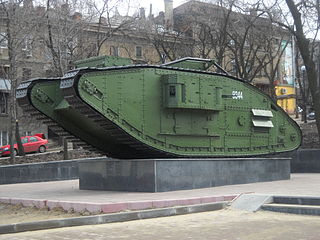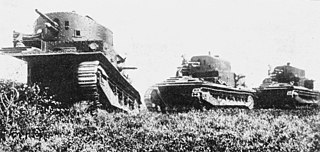
The Infantry Tank Mark II, best known as the Matilda, was a British infantry tank of the Second World War.

The Vickers 6-ton tank or Vickers Mark E, also known as the "Six-tonner" was a British light tank designed as a private project at Vickers. It was not adopted by the British Army, but was picked up by many foreign armed forces. It was licensed by the Soviet Union as the T-26. It was also the direct predecessor of the Polish 7TP tank.

The Tank, Infantry, Mk IV (A22) Churchill was a British infantry tank used in the Second World War, best known for its heavy armour, large longitudinal chassis with all-around tracks with multiple bogies, its ability to climb steep slopes, and its use as the basis of many specialist vehicles. It was one of the heaviest Allied tanks of the war.

The Tank, Cruiser, Mk II (A10), was a cruiser tank developed alongside the A9 cruiser tank, and was intended to be a heavier, infantry tank version of that type. In practice, it was not deemed suitable for the infantry tank role and was classified as a "heavy cruiser".

The Universal Carrier, also known as the Bren Gun Carrier and sometimes simply the Bren Carrier from the light machine gun armament, is a common name describing a family of light armoured tracked vehicles built by Vickers-Armstrongs and other companies.

British heavy tanks were a series of related armoured fighting vehicles developed by the UK during the First World War. The Mark I was the world's first tank, a tracked, armed, and armoured vehicle, to enter combat. The name "tank" was initially a code name to maintain secrecy and disguise its true purpose by making it appear to be a water transport vehicle for bringing water to the troops at the front line. The tank was developed in 1915 to break the stalemate of trench warfare. It could survive the machine gun and small-arms fire in "No Man's Land", travel over difficult terrain, crush barbed wire, and cross trenches to assault fortified enemy positions with powerful armament. Tanks also carried supplies and troops.

The Medium Mark B was a British tank of the First World War developed as a successor to the Whippet, but ultimately unsatisfactory and production was cancelled at the end of the war.

The Medium Mark C Hornet was a British tank developed during the First World War, but produced too late to see any fighting.

AEC Armoured Car is the name of a series of British heavy armoured cars built by the Associated Equipment Company (AEC) during the Second World War.

The Ordnance Quick-Firing 6-pounder 7 cwt, or just 6-pounder, was a British 57 mm gun, serving during the Second World War as a primary anti-tank gun of both the British and United States Army. It was also used as the main armament for a number of armoured fighting vehicles.

The "Female" tank was a variation of the British heavy tank deployed during the First World War. It carried multiple machine guns instead of the mix of machine guns and cannons mounted on the "male" tank. Lieutenant-Colonel Ernest Swinton, who played a part in the development of the first British tank and who was co-creator of the term "tank", is credited with inventing these gender-related terms, thinking that the best tank tactics would have the two types operating in concert.

The Vickers Medium Mark II was a British tank built by Vickers in the Inter-war period.

The Vickers Medium Mark I was a British tank of the Inter-war period built by Vickers from 1924.

The Besa machine gun was a British version of the Czechoslovak ZB-53 air-cooled, belt-fed machine gun.

The British Mark V tank was an upgraded version of the Mark IV tank.

The Mark IV was a British tank of the First World War. Introduced in 1917, it benefited from significant developments of the Mark I tank. The main improvements were in armour, the re-siting of the fuel tank and ease of transport. A total of 1,220 Mk IV were built: 420 "Males", 595 "Females" and 205 Tank Tenders, which made it the most numerous British tank of the war. The Mark IV was first used in mid 1917 at the Battle of Messines Ridge. It remained in British service until the end of the war, and a small number served briefly with other combatants afterwards.

The Ordnance QF 6-pounder 6 cwt Hotchkiss Mk I and Mk II was a shortened version of the original QF 6 pounder Hotchkiss naval gun, and was developed specifically for use in the sponsons of the later Marks of British tanks in World War I, from Mark IV onwards.

















